Numerical Investigation of the Effect of Incorporated Guide Vane Length with SCC Piston for High-Viscosity Fuel Applications
Abstract
1. Introduction
2. Computer Simulation
2.1. Engine Specification Model
2.2. Design Geometry of Piston-Bowl
2.3. Guide Vane Design (GVD)
3. Numerical Setting
4. Results and Discussion
4.1. Model Validation
4.2. Grid Independence Test (GIT)
4.3. Turbulence Kinetic Energy (TKE)
4.4. In-Cylinder Swirl (Rs), Tumble (RT), and Cross Tumble Ratio (RCT)
4.5. Characteristics of Cylinder Airflow During Intake and Compression Stroke
5. Conclusions
Author Contributions
Funding
Conflicts of Interest
Nomenclature
| English Symbol | Description | Unit |
| Three-dimensional flow velocities in the x, y, and z directions | m/s | |
| P | Pressure | Pa |
| 𝚝 | Time | s |
| Total enthalpy | J/kg | |
| Momentum source | N/m3 | |
| R | Radius | mm |
| l | Length | mm |
| x,y,z | Cartesian coordinates | mm |
| Greek Symbol | Description | Unit |
| 𝜌 | Fluid density | kg/m3 |
| ω | Angular acceleration | rad/s |
| λ | Thermal conductivity | W/m.K |
| θ | Crank angle degree | − |
| 𝜏 | Strain rate | 1/s |
| Vane twist angle | − | |
| Gradient operator | − | |
| Abbreviation | Description | |
| GVD | Guide vane design | |
| HVF | Higher viscosity fuel | |
| SCC | Shallow depth re-entrance combustion chamber | |
| SM | Momentum source | |
| RT | Tumble ratio | |
| SOI | Start of Injection | |
| SOC | Start of Combustion | |
| RS | Swirl ratio | |
| CI | Compression Ignition | |
| JME | Jatropha methyl ester | |
| HC | Hydrocarbons | |
| CA | Crank Angle | |
| RCT | Cross tumble ratio | |
| TKE | Turbulence kinetic energy |
References
- Mahmudul, H.M.; Hagos, F.Y.; Mamat, R.; Adam, A.A.; Ishak, W.F.W.; Alenezi, R. Production, characterization and performance of biodiesel as an alternative fuel in diesel engines—A review. Renew. Sustain. Energy Rev. 2017, 72, 497–509. [Google Scholar] [CrossRef]
- Sivaganesan, S.; Chandrasekaran, M. Impact of various compression ratio on the compression ignition engine with diesel and mahua biodiesel. Int. J. ChemTech Res. 2016, 9, 63–70. [Google Scholar]
- Hamid, M.F.; Idroas, M.Y.; Basha, M.H.; Sa’ad, S.; Che Mat, S.; Abdullah, M.K.; Zainal Alauddin, Z.A. Numerical study on dissimilar guide vane design with SCC piston for air and emulsified biofuel mixing improvement. MATEC Web Conf. 2016, 90, 01065. [Google Scholar] [CrossRef]
- International Energy Agency. World Energy Outlook Special Report: Energy and Climate Change; International Energy Agency: Paris, France, 15 June 2015. [Google Scholar]
- Popp, J.; Lakner, Z.; Harangi-Rákos, M.; Fári, M. The effect of bioenergy expansion: Food, energy, and environment. Renew. Sustain. Energy Rev. 2014, 32, 559–578. [Google Scholar] [CrossRef]
- Azad, A.K.; Rasul, M.G.; Khan, M.M.K.; Sharma, S.C.; Hazrat, M.A. Prospect of biofuels as an alternative transport fuel in Australia. Renew. Sustain. Energy Rev. 2015, 43, 331–351. [Google Scholar] [CrossRef]
- Nalgundwar, A.; Paul, B.; Sharma, S.K. Comparison of performance and emissions characteristics of di CI engine fueled with dual biodiesel blends of palm and jatropha. Fuel 2016, 173, 172–179. [Google Scholar] [CrossRef]
- Reham, S.S.; Masjuki, H.H.; Kalam, M.A.; Shancita, I.; Rizwanul Fattah, I.M.; Ruhul, A.M. Study on stability, fuel properties, engine combustion, performance and emission characteristics of biofuel emulsion. Renew. Sustain. Energy Rev. 2015, 52, 1566–1579. [Google Scholar] [CrossRef]
- Annamalai, M.; Dhinesh, B.; Nanthagopal, K.; SivaramaKrishnan, P.; Isaac JoshuaRamesh Lalvani, J.; Parthasarathy, M.; Annamalai, K. An assessment on performance, combustion and emission behavior of a diesel engine powered by ceria nanoparticle blended emulsified biofuel. Energy Convers. Manag. 2016, 123, 372–380. [Google Scholar] [CrossRef]
- Ayhan, V.; Tunca, S. Experimental investigation on using emulsified fuels with different biofuel additives in a DI diesel engine for performance and emissions. Appl. Therm. Eng. 2018, 129, 841–854. [Google Scholar] [CrossRef]
- Prakash, R.; Singh, R.K.; Murugan, S. Experimental studies on combustion, performance and emission characteristics of diesel engine using different biodiesel bio oil emulsions. J. Energy Inst. 2015, 88, 64–75. [Google Scholar] [CrossRef]
- Raheman, H.; Kumari, S. Combustion characteristics and emissions of a compression ignition engine using emulsified jatropha biodiesel blend. Biosyst. Eng. 2014, 123, 29–39. [Google Scholar] [CrossRef]
- Dhinesh, B.; Annamalai, M. A study on performance, combustion and emission behaviour of diesel engine powered by novel nano nerium oleander biofuel. J. Clean. Prod. 2018, 196, 74–83. [Google Scholar] [CrossRef]
- Che Mat, S.; Idroas, M.Y.; Hamid, M.F.; Zainal, Z.A. Performance and emissions of straight vegetable oils and its blends as a fuel in diesel engine: A review. Renew. Sustain. Energy Rev. 2018, 82, 808–823. [Google Scholar] [CrossRef]
- Ramesh, A.; Ashok, B.; Nanthagopal, K.; Ramesh Pathy, M.; Tambare, A.; Mali, P.; Phuke, P.; Patil, S.; Subbarao, R. Influence of hexanol as additive with Calophyllum Inophyllum biodiesel for CI engine applications. Fuel 2019, 249, 472–485. [Google Scholar] [CrossRef]
- Ashok, B.; Nantha Gopal, K.; Rajagopal, T.K.R.; Alagiasingam, S.; Appu, S.; Murugan, A. Design and analysis of a fuel preheating device for evaluation of ethanol based biofuel blends in a diesel engine application. SAE Int. J. Engines 2017, 10, 39–45. [Google Scholar] [CrossRef]
- Mofijur, M.; Rasul, M.G.; Hyde, J.; Azad, A.K.; Mamat, R.; Bhuiya, M.M.K. Role of biofuel and their binary (diesel-biodiesel) and ternary (ethanol-biodiesel-diesel) blends on internal combustion engines emission reduction. Renew. Sustain. Energy Rev. 2016, 53, 265–278. [Google Scholar] [CrossRef]
- Vallinayagam, R.; Vedharaj, S.; Yang, W.M.; Lee, P.S.; Chua, K.J.E.; Chou, S.K. Pine oil-biodiesel blends: A double biofuel strategy to completely eliminate the use of diesel in a diesel engine. Appl. Energy 2014, 130, 466–473. [Google Scholar] [CrossRef]
- Mat, S.C.; Idroas, M.Y.; Teoh, Y.H.; Hamid, M.F. Physicochemical, performance, combustion and emission characteristics of melaleuca cajuputi oil-refined palm oil hybrid biofuel blend. Energies 2018, 11, 3146. [Google Scholar] [CrossRef]
- Koc, A.B.; Abdullah, M. Performance and NOx emissions of a diesel engine fueled with biodiesel-diesel-water nanoemulsions. Fuel Process. Technol. 2013, 109, 70–77. [Google Scholar] [CrossRef]
- Tan, Y.H.; Abdullah, M.O.; Nolasco-Hipolito, C. The potential of waste cooking oil-based biodiesel using heterogeneous catalyst derived from various calcined eggshells coupled with an emulsification technique: A review on the emission reduction and engine performance. Renew. Sustain. Energy Rev. 2015, 47, 589–603. [Google Scholar] [CrossRef]
- Agarwal, A.K. Biofuels (alcohols and biodiesel) applications as fuels for internal combustion engines. Prog. Energy Combust. Sci. 2007, 33, 233–271. [Google Scholar] [CrossRef]
- Bari, S.; Saad, I. Performance and emissions of a compression ignition (CI) engine run with biodiesel using guide vanes at varied vane angles. Fuel 2015, 143, 217–228. [Google Scholar] [CrossRef]
- Bari, S.; Saad, I. Optimization of vane numbers through simulation and experiment, and investigation of the effect on the performance and emissions of a CI (compression ignition) engine run with biodiesel. Energy 2015, 79, 248–263. [Google Scholar] [CrossRef]
- Bari, S.; Saad, I. Effect of guide vane height on the performance and emissions of a compression ignition (CI) engine run with biodiesel through simulation and experiment. Appl. Energy 2014, 136, 431–444. [Google Scholar] [CrossRef]
- Saad, I.; Bari, S. Improving Air-Fuel Mixing in Diesel Engine Fuelled by Higher Viscous Fuel Using Guide Vane Swirl and Tumble Device (GVSTD); SAE Technical Papers; SAE: Warrendale, PA, USA, 2013. [Google Scholar]
- Hamid, M.F.; Idroas, M.Y.; Sa’ad, S.; Saiful Bahri, A.J.; Sharzali, C.M.; Abdullah, M.K.; Zainal, Z.A. Numerical investigation of in-cylinder air flow characteristic improvement for Emulsified biofuel (EB) application. Renew. Energy 2018, 127, 84–93. [Google Scholar] [CrossRef]
- Lalvani, J.I.J.R.; Prakash, E.; Parthasarathy, M.; Jayaraj, S.; Annamalai, K. Structural Analysis on Swirling Grooved SCC Piston. In Advanced Materials Research; Trans Tech Publications Ltd.: Stafa-Zurich, Switzerland, 2014. [Google Scholar]
- Yadav, P.; Saravanan, C.G.; Edward, J.G.; Perumal, R. Experimental and Numerical Investigation of Flow and Combustion in a di Diesel Engine with Different Piston Geometries; SAE Technical Papers; SAE: Warrendale, PA, USA, 2015. [Google Scholar]
- Gaburro, E.; Dumbser, M.; Castro, M.J. Direct Arbitrary-Lagrangian-Eulerian finite volume schemes on moving nonconforming unstructured meshes. Comput. Fluids 2017, 159, 254–275. [Google Scholar] [CrossRef]
- Bianchi, G.; Rane, S.; Kovacevic, A.; Cipollone, R. Deforming grid generation for numerical simulations of fluid dynamics in sliding vane rotary machines. Adv. Eng. Softw. 2017, 112, 180–191. [Google Scholar] [CrossRef]
- ANSYS Inc. ANSYS Fluent, Release 19.1, Help System, Theory Guide; ANSYS Inc.: Washington, PA, USA, 2018. [Google Scholar]
- Gao, R.; Liu, K.; Li, A.; Fang, Z.; Yang, Z.; Cong, B. Study of the shape optimization of a tee guide vane in a ventilation and air-conditioning duct. Build. Environ. 2018, 132, 345–356. [Google Scholar] [CrossRef]
- Hamid, M.F.; Abdullah, M.K.; Idroas, M.Y.; Alauddin, Z.A.Z.; Sharzali, C.M.; Khimi, S.R.; Sa’Ad, S. Effect of vane numbers on the in-cylinder air flow characteristic in compression ignition (CI) engine run with emulsified biofuel. Mater. Today Proc. 2019, 17, 989–994. [Google Scholar] [CrossRef]
- Payri, F.; Benajes, J.; Margot, X.; Gil, A. CFD modeling of the in-cylinder flow in direct-injection Diesel engines. Comput. Fluids 2004, 33, 995–1021. [Google Scholar] [CrossRef]
- Payri, R.; Salvador, F.J.; Gimeno, J.; Zapata, L.D. Diesel nozzle geometry influence on spray liquid-phase fuel penetration in evaporative conditions. Fuel 2008, 87, 1165–1176. [Google Scholar] [CrossRef]
- Broatch, A.; Olmeda, P.; García, A.; Salvador-Iborra, J.; Warey, A. Impact of swirl on in-cylinder heat transfer in a light-duty diesel engine. Energy 2017, 119, 1010–1023. [Google Scholar] [CrossRef]
- Benajes, J.; Olmeda, P.; Martín, J.; Blanco-Cavero, D.; Warey, A. Evaluation of swirl effect on the Global Energy Balance of a HSDI Diesel engine. Energy 2017, 122, 168–181. [Google Scholar] [CrossRef]
- Wang, T.; Liu, D.; Tan, B.; Wang, G.; Peng, Z. An investigation into in-cylinder tumble flow characteristics with variable valve lift in a gasoline engine. Flow Turbul. Combust. 2015, 94, 285–304. [Google Scholar] [CrossRef]
- Buhl, S.; Gleiss, F.; Köhler, M.; Hartmann, F.; Messig, D.; Brücker, C.; Hasse, C. A Combined Numerical and Experimental Study of the 3D Tumble Structure and Piston Boundary Layer Development During the Intake Stroke of a Gasoline Engine. Flow Turbul. Combust. 2017, 98, 579–600. [Google Scholar] [CrossRef]
- Bari, S.; Saad, I. CFD modelling of the effect of guide vane swirl and tumble device to generate better in-cylinder air flow in a CI engine fuelled by biodiesel. Comput. Fluids 2013, 84, 262–269. [Google Scholar] [CrossRef]
- Hamid, M.F.; Idroas, M.Y.; Sa’ad, S.; Yew Heng, T.; Che Mat, S.; Zainal Alauddin, Z.A.; Shamsuddin, K.A.; Shuib, R.K.; Abdullah, M.K. Numerical Investigation of Fluid Flow and In-Cylinder Air Flow Characteristics for Higher Viscosity Fuel Applications. Processes 2020, 8, 439. [Google Scholar] [CrossRef]
- Prasad, B.V.V.S.U.; Sharma, C.S.; Anand, T.N.C.; Ravikrishna, R.V. High swirl-inducing piston bowls in small diesel engines for emission reduction. Appl. Energy 2011, 88, 2355–2367. [Google Scholar] [CrossRef]
- Heywood, J.B. Internal Combustion Engine Fundamentals; McGraw Hill International: New York, NY, USA, 1988. [Google Scholar]
Publisher’s Note: MDPI stays neutral with regard to jurisdictional claims in published maps and institutional affiliations. |
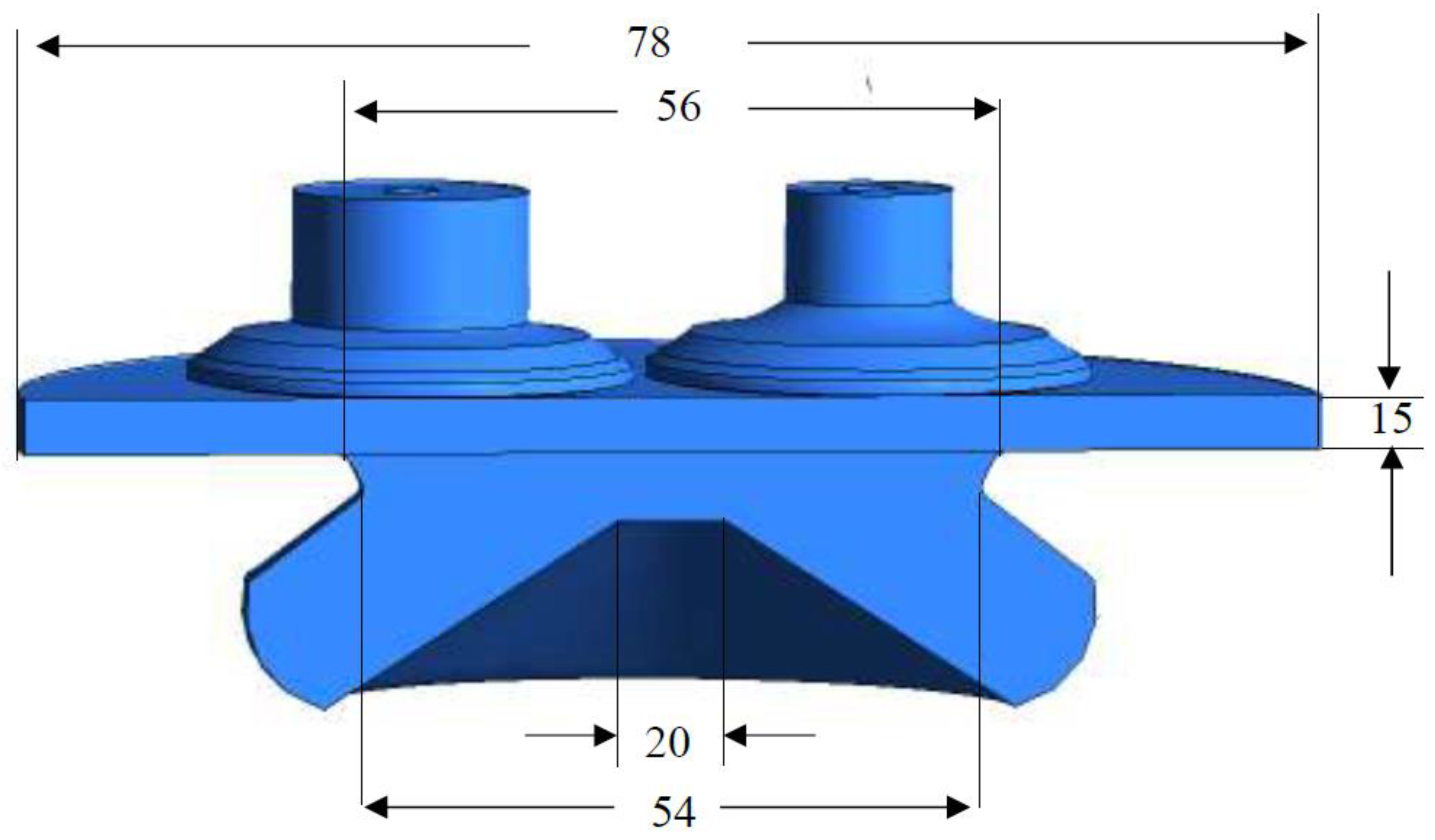
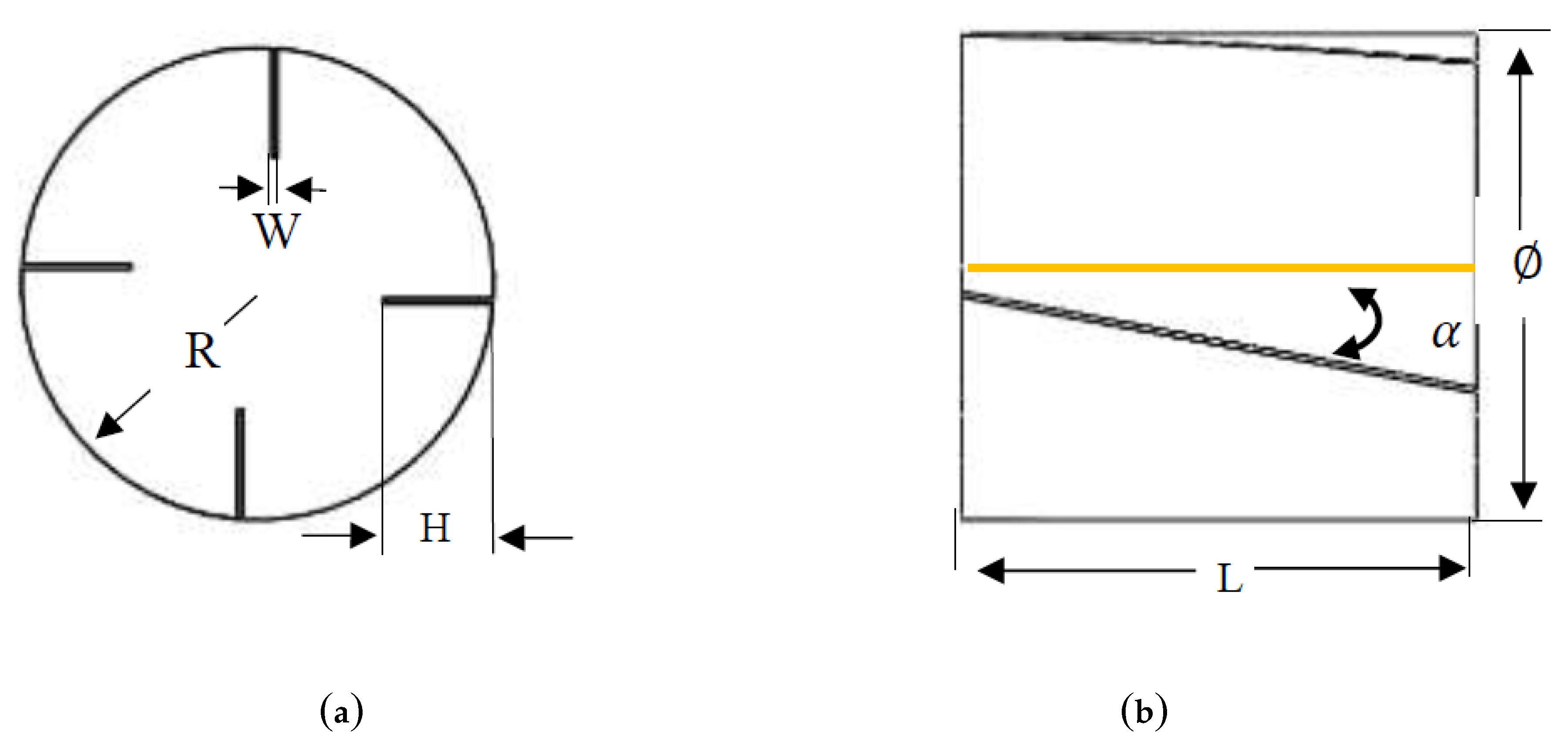
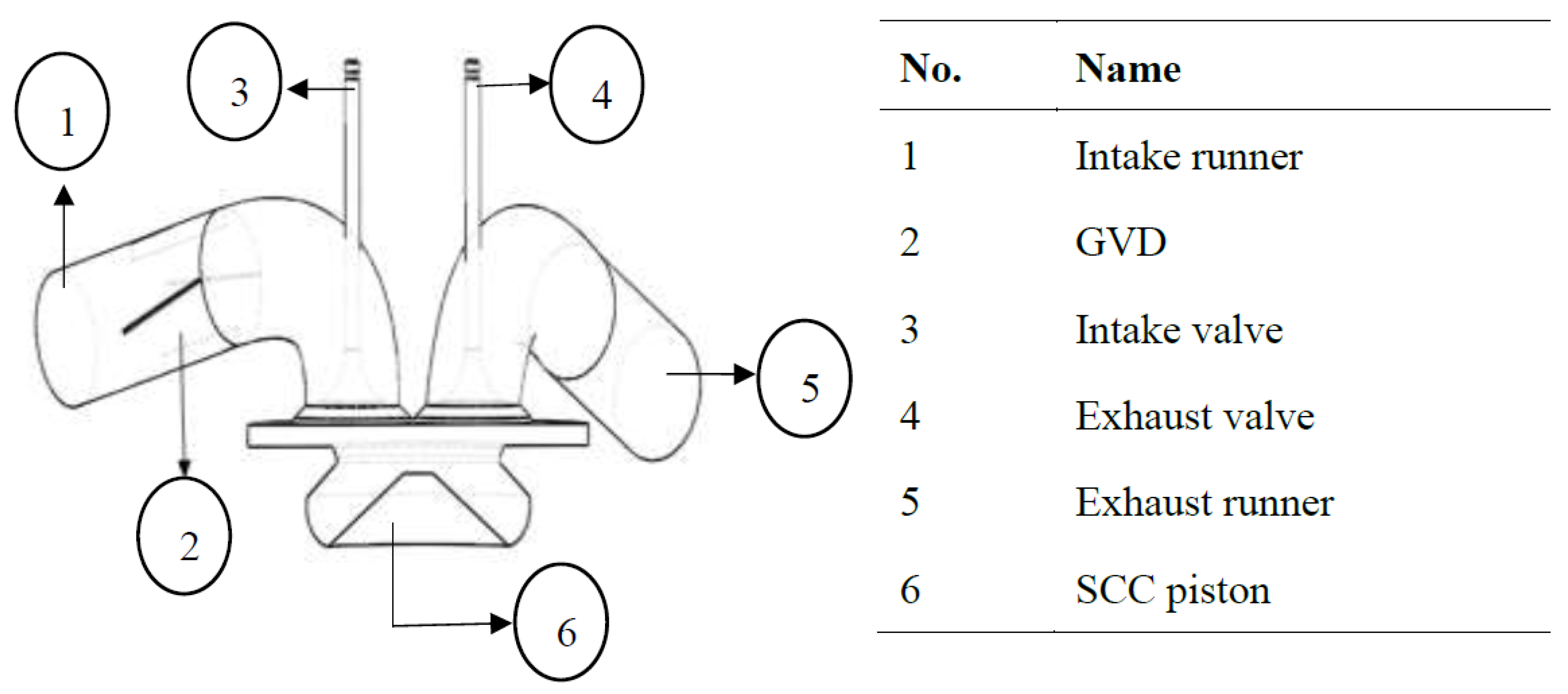
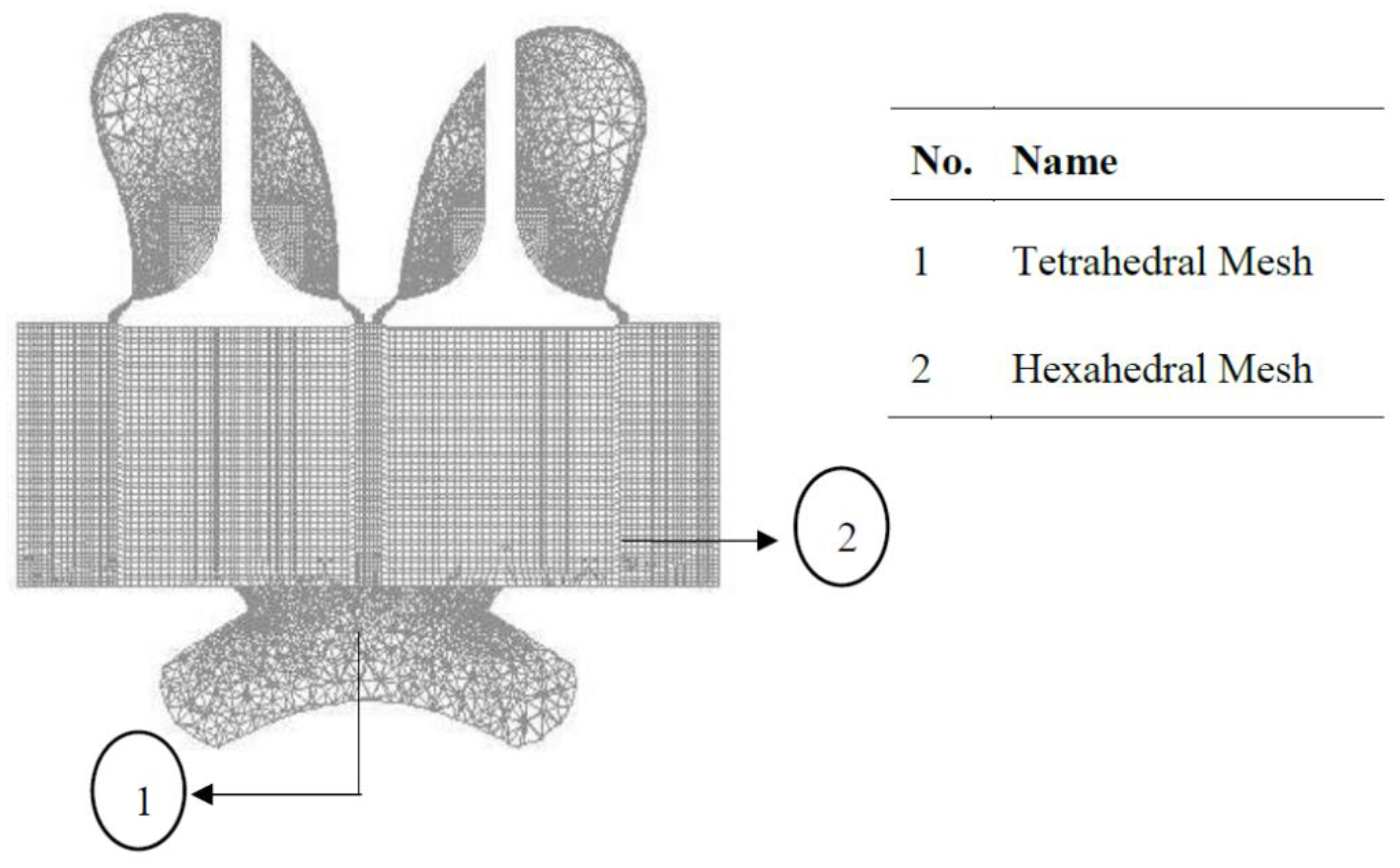
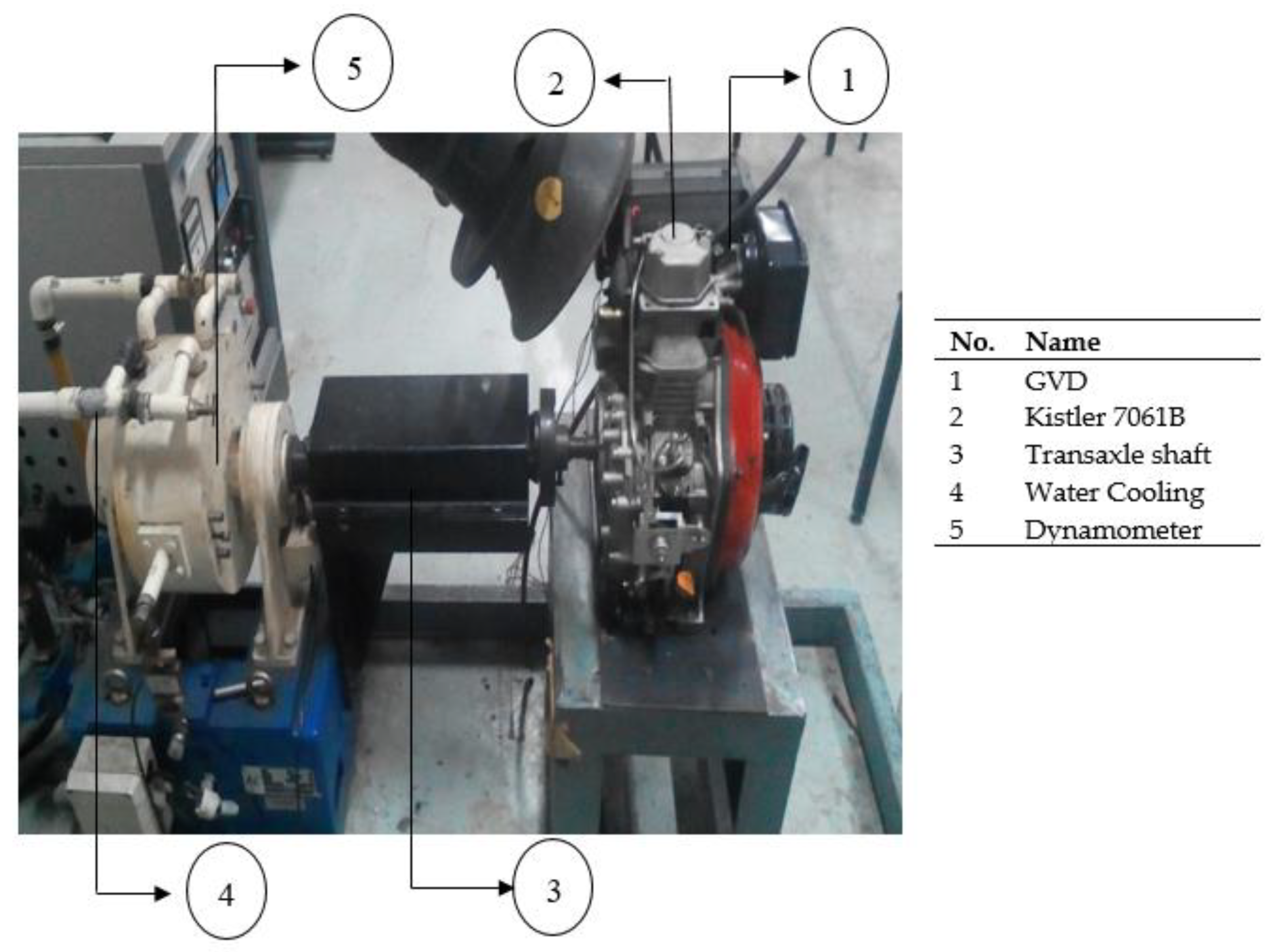
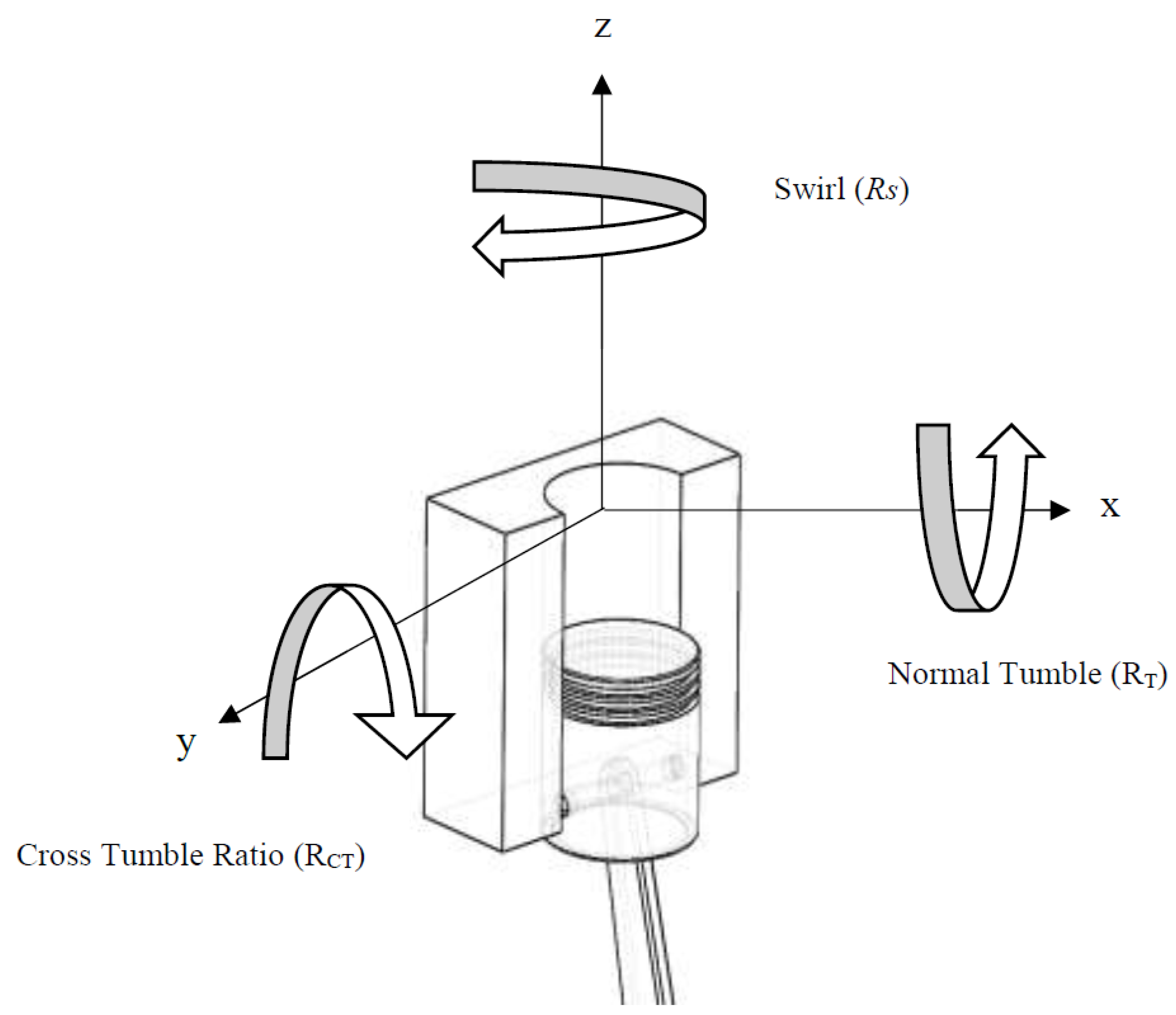
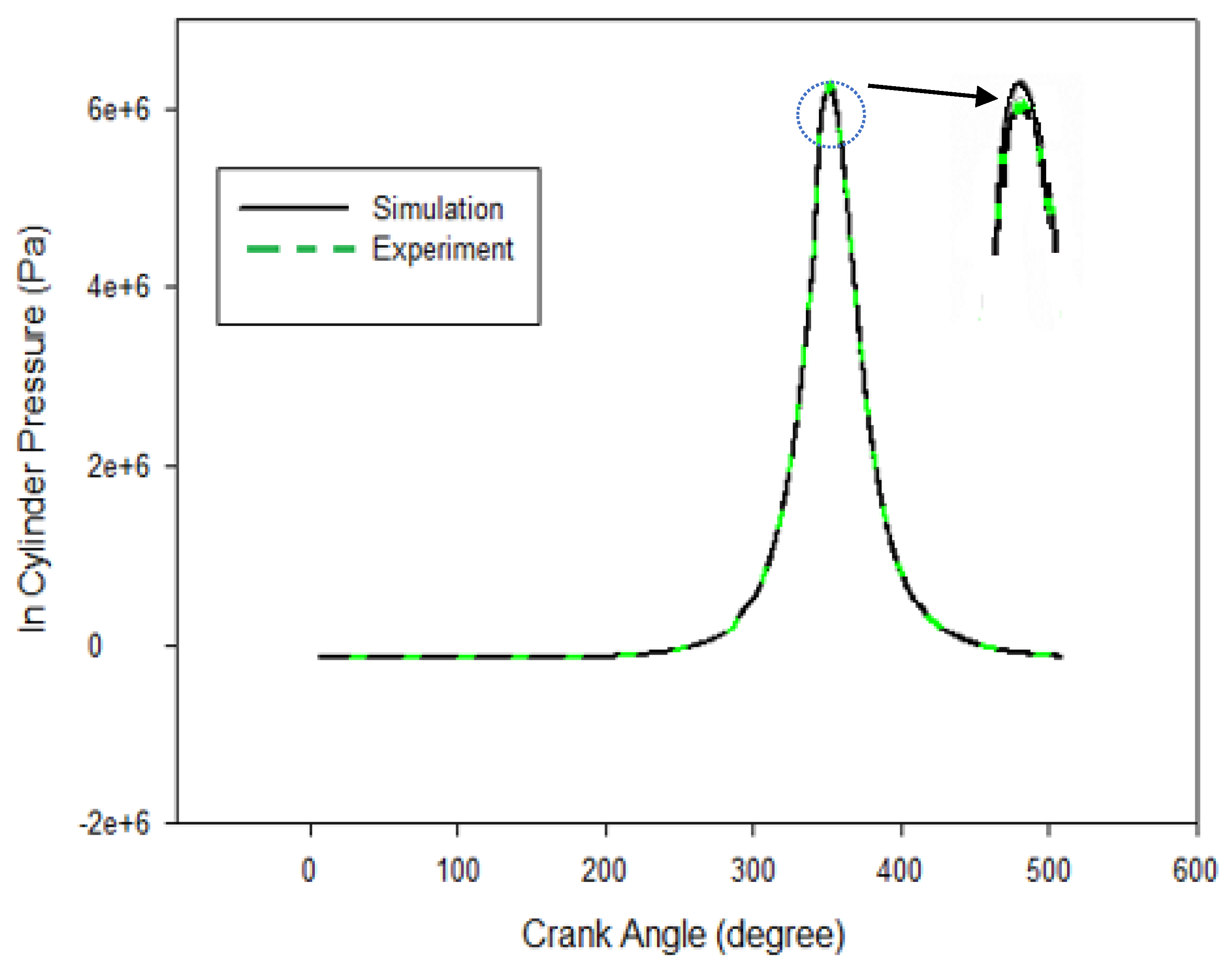
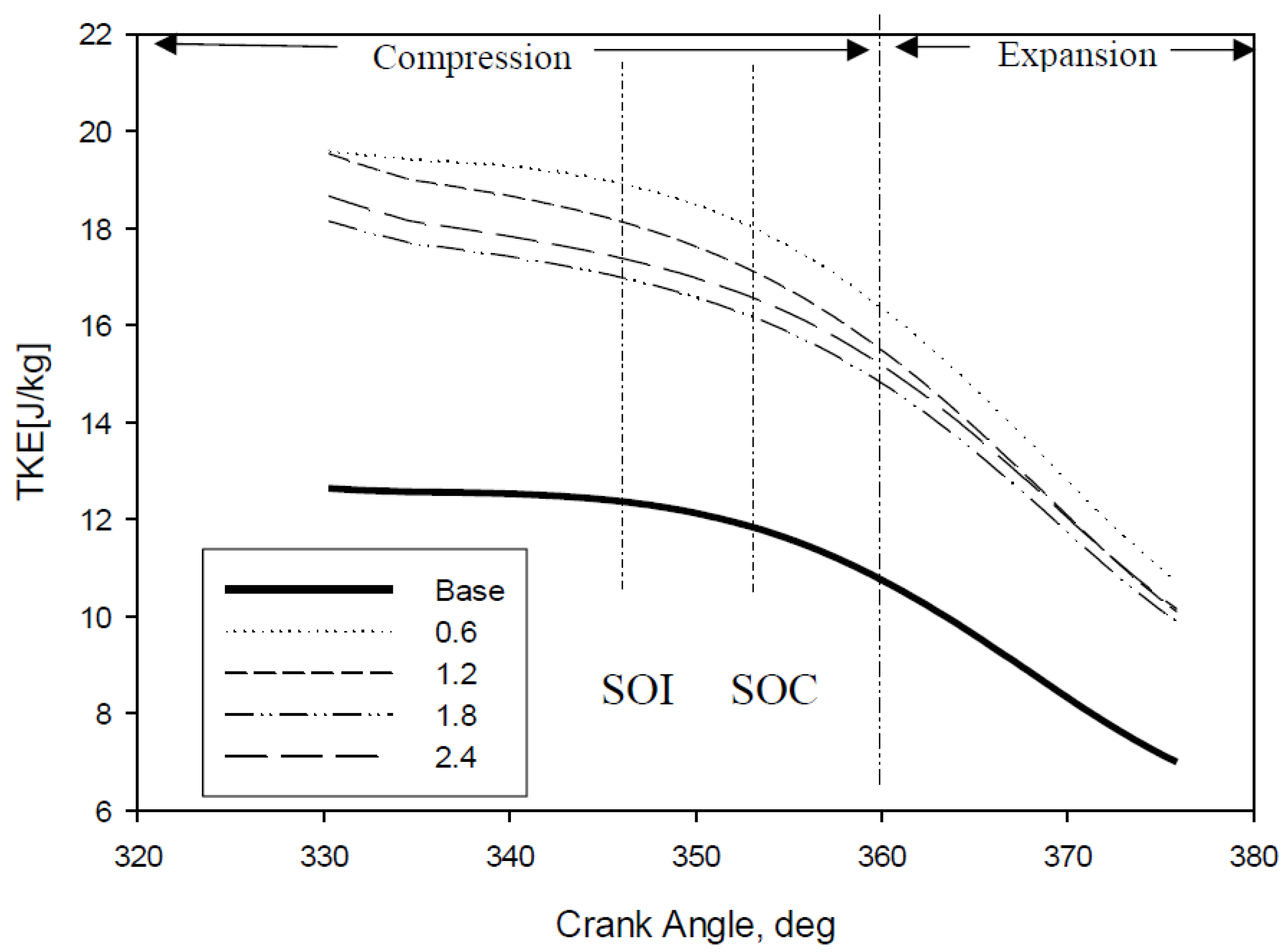
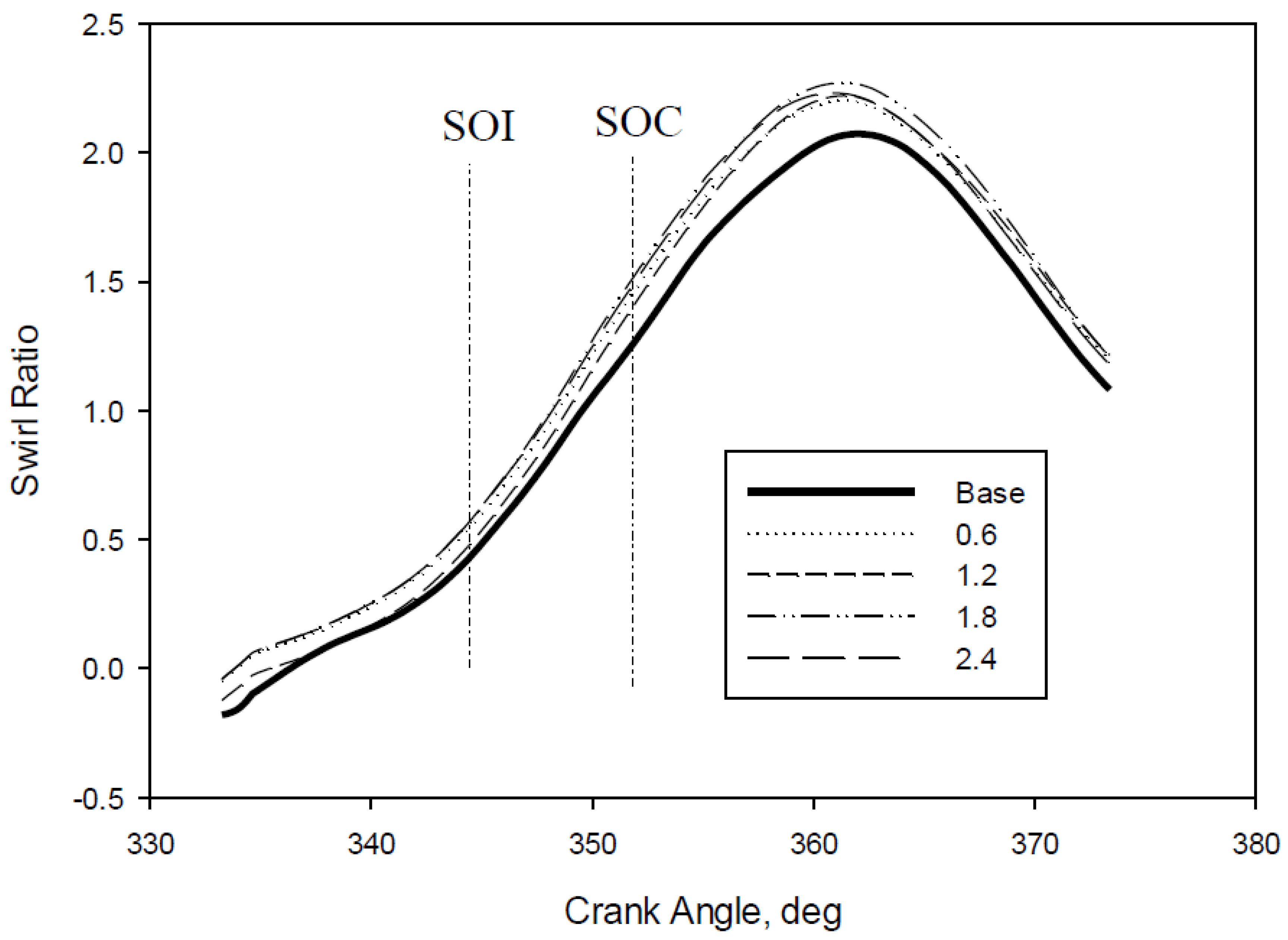
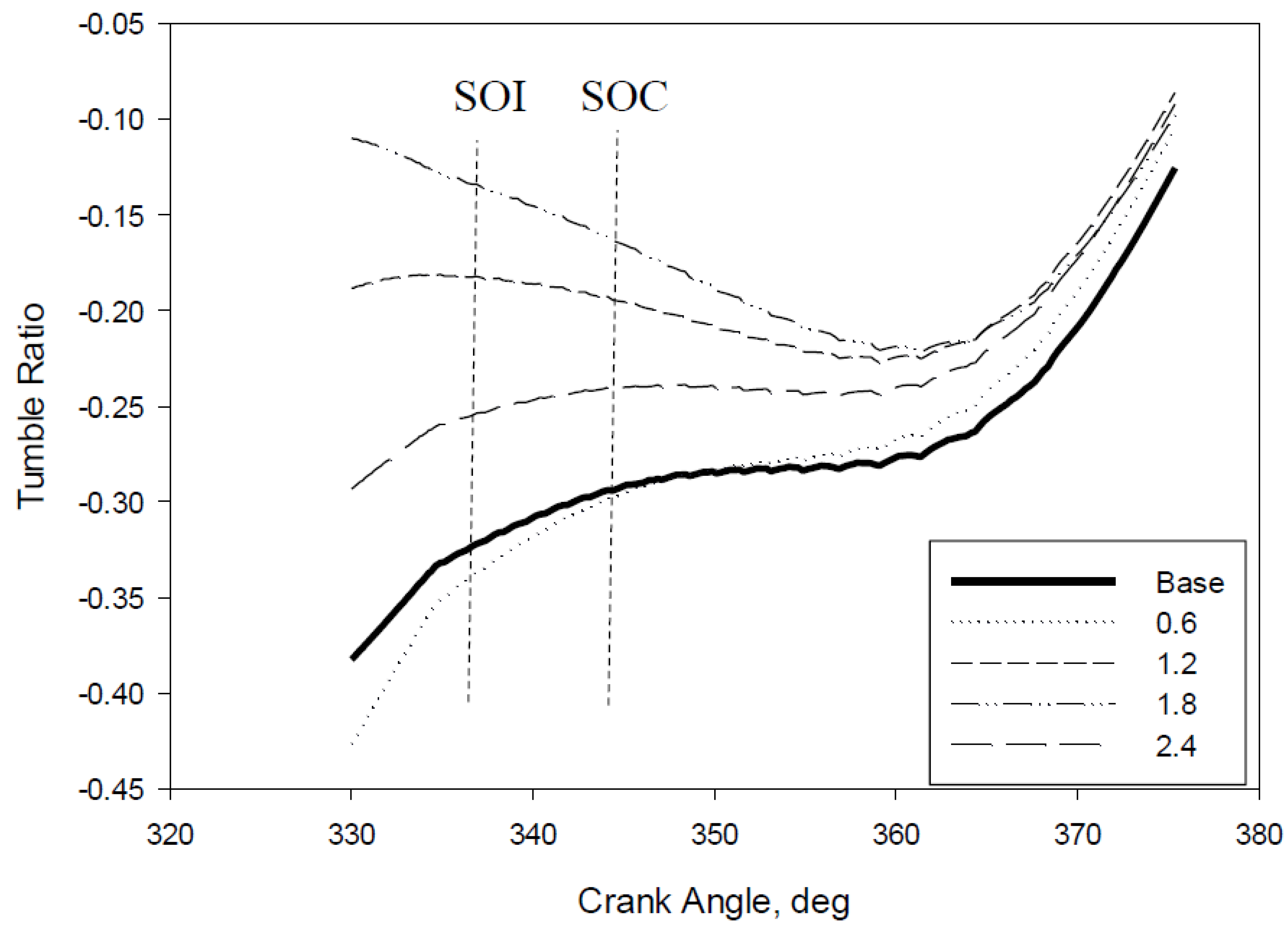

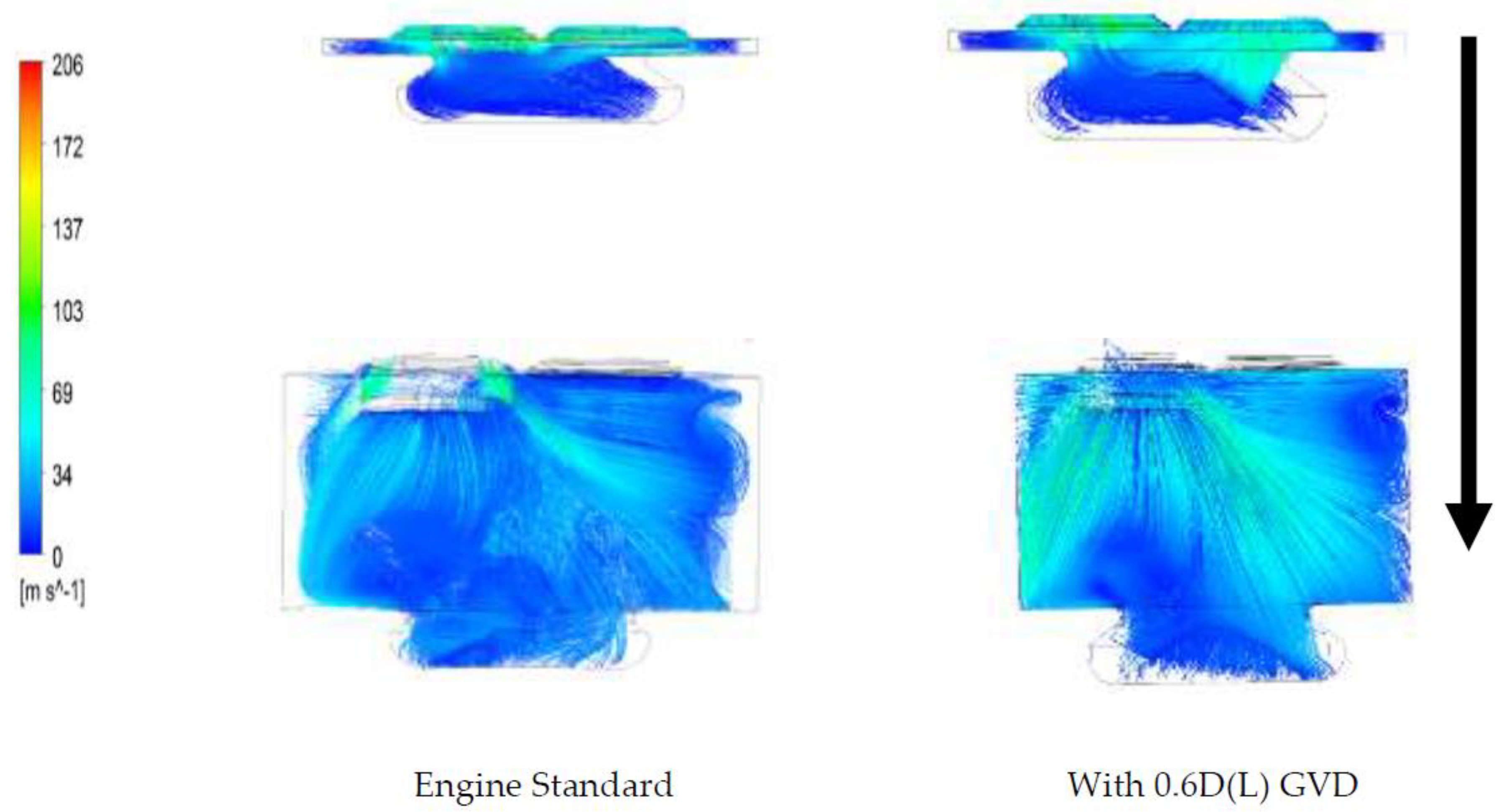

| Engine Parameter | Detail |
|---|---|
| Model | Yanmar L70AE |
| Bore | 78 mm |
| Stroke | 62 mm |
| Compression ratio | 19.1 |
| Number of cylinders | 1 |
| Weight | 36 kg |
| Type of injection | Direct injection |
| Fuel injection pressure | 19.6 Mpa |
| Displacement | 0.296 L |
| High idle speed | 3600 rpm |
| Injection timing | 14 + 1 BTDC |
| Intake | Naturally aspirated |
| Direct of rotation | Counterclockwise |
| GVD Parameter | Parameter Detail |
|---|---|
| Number of vanes | 4 |
| Width of vane (W) | 0.5 mm |
| Height of vane (H) | 0.60R |
| Length of vane (L) | 0.6D (L), 1.2D (L), 1.8D (L), 2.4D (L) and 3.0D (L) |
| Vane twist angle () | 35° |
| Case | 1 | 2 | 3 | 4 | 5 |
|---|---|---|---|---|---|
| Elements average cylinder | 101,191 | 249,543 | 301,142 | 369,178 | 446,769 |
| Pressure (Pa) | 2.013 × 106 | 3.109 × 106 | 3.160 × 106 | 3.160 × 106 | 3.160 × 106 |
© 2020 by the authors. Licensee MDPI, Basel, Switzerland. This article is an open access article distributed under the terms and conditions of the Creative Commons Attribution (CC BY) license (http://creativecommons.org/licenses/by/4.0/).
Share and Cite
Hamid, M.F.; Idroas, M.Y.; Mohamed, M.; Sa'ad, S.; Yew Heng, T.; Che Mat, S.; Miskam, M.A.; Zainal Alauddin, Z.A.; Abdullah, M.K. Numerical Investigation of the Effect of Incorporated Guide Vane Length with SCC Piston for High-Viscosity Fuel Applications. Processes 2020, 8, 1328. https://doi.org/10.3390/pr8111328
Hamid MF, Idroas MY, Mohamed M, Sa'ad S, Yew Heng T, Che Mat S, Miskam MA, Zainal Alauddin ZA, Abdullah MK. Numerical Investigation of the Effect of Incorporated Guide Vane Length with SCC Piston for High-Viscosity Fuel Applications. Processes. 2020; 8(11):1328. https://doi.org/10.3390/pr8111328
Chicago/Turabian StyleHamid, Mohd Fadzli, Mohamad Yusof Idroas, Mazlan Mohamed, Shukriwani Sa'ad, Teoh Yew Heng, Sharzali Che Mat, Muhamad Azman Miskam, Zainal Alimuddin Zainal Alauddin, and Muhammad Khalil Abdullah. 2020. "Numerical Investigation of the Effect of Incorporated Guide Vane Length with SCC Piston for High-Viscosity Fuel Applications" Processes 8, no. 11: 1328. https://doi.org/10.3390/pr8111328
APA StyleHamid, M. F., Idroas, M. Y., Mohamed, M., Sa'ad, S., Yew Heng, T., Che Mat, S., Miskam, M. A., Zainal Alauddin, Z. A., & Abdullah, M. K. (2020). Numerical Investigation of the Effect of Incorporated Guide Vane Length with SCC Piston for High-Viscosity Fuel Applications. Processes, 8(11), 1328. https://doi.org/10.3390/pr8111328







